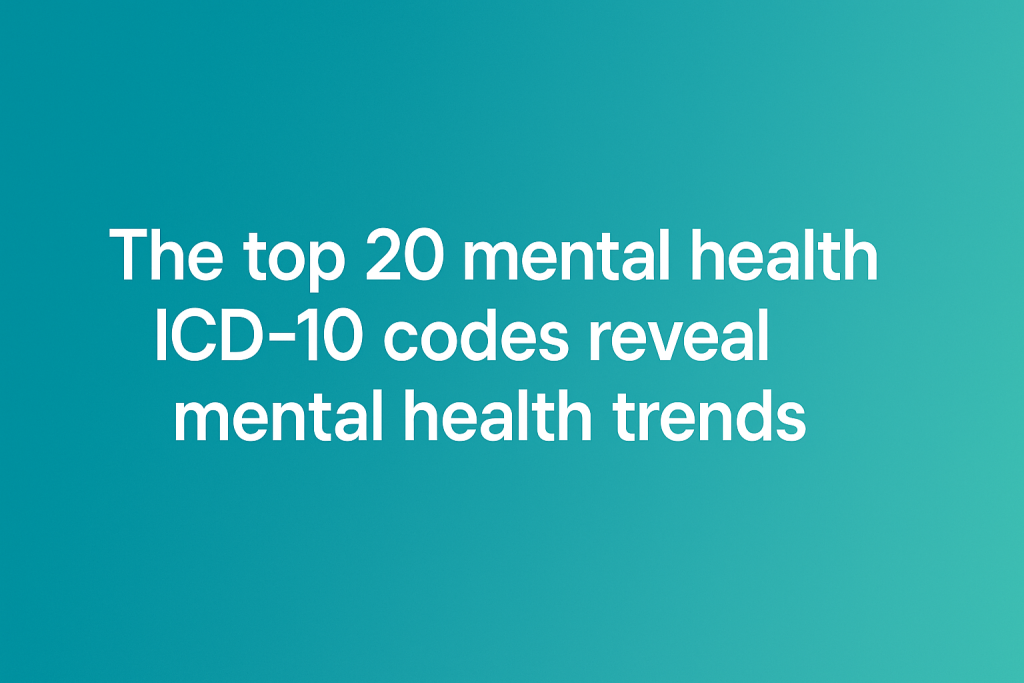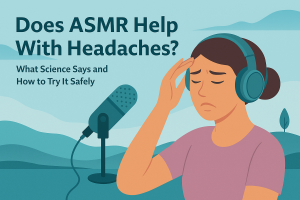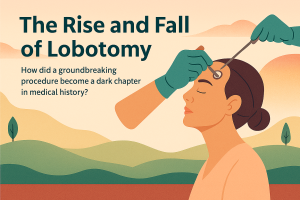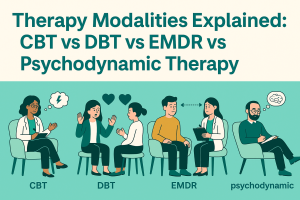After a decade immersed in the world of mental health billing and practice management, I can tell you this: the ICD-10 code isn't just a compliance requirement; it’s a high-resolution snapshot of our collective mental state.
Analyzing the top 20 mental health ICD-10 codes reveal mental health trends that are impossible to ignore—from the chronic ubiquity of anxiety to the rising visibility of neurodevelopmental conditions.
Forget the clinical jargon for a moment; these codes are mapping out the landscape of human suffering in America. In this definitive guide, I will take you past the codes themselves and show you *what they really mean* for your clinical strategy, your documentation, and your reimbursement integrity. If you want to future-proof your practice and provide truly relevant care, understanding these trends is your next critical step.
Decoding the Dominant Diagnoses: What the Numbers Mean
The top 20 mental health ICD-10 codes consistently tell a story dominated by two core issues: Anxiety and Depression. While the specific rankings shift annually, the dominance of these two categories highlights the fundamental challenges facing modern society. When I look at the raw data, I don't just see claim frequency; I see the faces of patients struggling with relentless, low-grade stress that has become the new normal.
Key Takeaway: The Reigning ICD-10 Champions
Year after year, Generalized Anxiety Disorder (F41.1) maintains its position as the single most frequently billed mental health diagnosis. This signifies that chronic, persistent worry—not episodic panic or severe distress—is the most pervasive issue our clinics address. We must tailor our service offerings to effectively manage this pervasive condition. For an in-depth breakdown of this code, see our guide on ICD-10 Codes for Anxiety.
For practices focused on revenue cycle management, understanding the subtle variations in these top codes is vital. It’s the difference between a clean claim and a denial. For instance, Major Depressive Disorder (MDD) is rarely billed as a simple, unspecified F32.9. Instead, codes like F33.1 (Recurrent, Moderate) or F32.1 (Single Episode, Moderate) appear frequently, emphasizing the importance of documenting *severity* and *episodic nature*—details that reinforce the medical necessity of long-term treatment.
Top 10 Most Frequent Mental Health ICD-10 Codes (Sample Trend Data)
| Rank | ICD-10 Code | Diagnosis Description | Clinical Significance |
|---|---|---|---|
| 1 | F41.1 | Generalized Anxiety Disorder | The core diagnosis for chronic, persistent worry; the highest volume code. |
| 2 | F43.23 | Adjustment Disorder with Mixed Anxiety and Depressed Mood | The diagnosis for stressor-related distress; high volume post-COVID. |
| 3 | F33.1 | Major Depressive Disorder, Recurrent, Moderate | Indicates ongoing, cyclical mood issues requiring consistent care. |
| 4 | F43.22 | Adjustment Disorder with Anxiety | Acute stress response primarily manifesting as anxious symptoms. |
| 5 | F90.2 | ADHD, Combined Type | A rising trend, reflecting increased awareness and childhood/adult diagnosis. |
| 6 | F41.9 | Anxiety Disorder, Unspecified | Used when criteria are met but specificity is lacking (use sparingly). |
| 7 | F43.12 | Post Traumatic Stress Disorder (PTSD), Chronic | Used for trauma symptoms lasting over 3 months. Essential for specialized therapies like EMDR. |
| 8 | F43.20 | Adjustment Disorder, Unspecified | Represents a time-limited reaction to an event, but lacks symptom detail. |
| 9 | F90.0 | ADHD, Predominantly Inattentive Type | Often seen in adult women and girls; reflects cognitive focus challenges. |
| 10 | Z63.0 | Problem in relationship with spouse or partner | A significant Z-code that justifies couples or family therapy (secondary diagnosis). |
The Evolving Landscape: Why ADHD, Adjustment, and Autism Codes Are Soaring
The most fascinating aspect of analyzing the top 20 mental health ICD-10 codes reveal mental health trends is observing the shift in diagnoses that weren't always in the top spots. The surge in codes for Attention-Deficit Hyperactivity Disorder (ADHD, F90.x) and the persistent presence of Adjustment Disorders (F43.2x) are signals of societal stress and diagnostic progress.
1. The Rise of Neurodiversity (F90.x & F84.0)
When I started out a decade ago, ADHD was primarily a childhood diagnosis. Today, F90.0 (Predominantly Inattentive Type) and F90.2 (Combined Type) are increasingly being billed for adults. Why? Better awareness, especially for the inattentive presentation which often mimics anxiety or depression in adult women. My personal insight is that the demands of the digital economy have made executive function deficits far more visible and debilitating. It’s no longer just about hyperactivity; it’s about the struggle to focus and organize in a world of constant notification streams. The same can be said for Autistic Disorder (F84.0)—diagnoses are climbing, particularly in adulthood, as clinicians recognize the subtler presentation of the Autism Spectrum.
2. The Normalization of Adjustment Distress (F43.2x)
The cluster of Adjustment Disorder codes (F43.23 for mixed anxiety/depression is a particular powerhouse) confirms that our society is saturated with stressors. Adjustment Disorders are, by definition, responses to identifiable life events—grief, job loss, relocation, or simply surviving years of global uncertainty. They indicate a system overwhelmed, where symptoms don't meet the full criteria for MDD or GAD but demand clinical intervention. Clinicians must be precise here: the code must reflect the specific symptomology (anxiety, depression, or both) to justify the intervention.
Beyond the Common: Chronic Conditions and Specialized Care
While the top codes handle volume, other key codes reveal the depth of clinical need and the increasing demand for specialization:
Chronic Trauma and PTSD (F43.12)
The code F43.12 (Post Traumatic Stress Disorder, Chronic) is vital. Chronic PTSD is trauma-related suffering that persists beyond three months. This distinction allows for the justification of more intensive, evidence-based therapies. For instance, when documenting the need for therapeutic techniques like EMDR, the specific diagnosis of F43.12 provides the required specificity. Understanding the nuances of ICD-10 Codes for PTSD is non-negotiable for trauma specialists.
Substance Use and Addiction (F11.20 Opioid Dependence)
The inclusion of codes for substance use, such as F11.20 (Opioid Dependence, Uncomplicated), in the top list is a sobering public health indicator. Mental health providers play a dual role here: treating the addiction itself and addressing the underlying mental health conditions (co-occurring depression, anxiety, trauma) that often fuel substance reliance. This demands integration of care models and an adherence to precise substance-related ICD-10 coding rules.
The Specificity Challenge: Schizophrenia and Psychosis
Codes for severe and chronic mental illnesses, such as Schizophrenia (F20.x) or Schizoaffective Disorder (F25.9), appear lower on the volume list but represent the highest clinical severity. For these complex cases, codes must be exact. Our detailed guide on Schizophrenia Symptoms and Treatment stresses this: precision in these codes dictates everything from medication management to hospital placement, making them critical for compliance and patient safety.
The Clinician's Edge: Strategic Coding for Maximum Reimbursement
As an expert who has spent years troubleshooting billing systems, I’ll share this foundational truth: Your diagnosis code (ICD-10) is only as good as its linkage to your service code (CPT). They must tell a congruent story. The financial health of your practice depends on this narrative integrity.
Expert Strategy: Linking ICD-10 to CPT
Poor Practice: ICD-10 F32.9 (MDD, Unspecified) linked to CPT 90837 (60-minute therapy). Payers often see 'unspecified' and question the need for a high-value service like 90837.
Optimized Practice: ICD-10 F33.1 (MDD, Recurrent, Moderate) linked to CPT 90837. The specificity of the ICD code justifies the length and nature of the psychotherapy session. Learn more about justifying service levels with CPT Code 99203 and similar codes.
The Power of Documentation (EEAT in Action)
The single most effective defense against claim denial is robust clinical documentation. Payers are not auditing for clinical quality; they are auditing for medical necessity, and that is built entirely on the specificity of your ICD-10 code and how your notes justify that code. I’ve seen practices recover thousands of dollars simply by transitioning from vague narrative notes to structured templates.
Documentation Deep Dive: Avoiding the Unspecified Trap
Actionable Strategy: Avoid using F41.9 ('Anxiety Disorder, Unspecified') and F32.9 ('Depression, Unspecified') unless it is for the first session and you plan to update it immediately. The goal of every diagnostic evaluation is to determine the specific sub-type, which means moving to F41.1 (GAD) or F33.1 (Recurrent MDD). Use a structured format like DAP Notes to ensure all components of the diagnosis are captured, protecting both your revenue and your license. Read our guide on How to Write DAP Notes for a compliant format.
New Horizons: Personality Traits and Emerging Clinical Entities
Beyond the core diagnostic trends, the use of ICD-10 codes suggests a growing focus on underlying personality traits and emotional processing deficits that hinder recovery from the top 20 disorders. This is where advanced clinicians demonstrate their EEAT by integrating subtle clinical observations into the formal coding structure.
1. Addressing Emotional Deficits: Alexithymia and Repression
Many patients presenting with codes like F41.1 or F33.1 struggle not just with symptoms, but with foundational issues in emotional regulation. Alexithymia, the difficulty identifying and describing emotions, is a powerful indicator of this. While it may not be a primary ICD-10 code, recognizing it informs the treatment plan for the primary diagnosis. Likewise, addressing Repressed Emotions is often the central work in therapy, leading to a deeper clinical rationale for long-term care.
If you suspect a personality factor is influencing treatment resistance, tools that quantify personality dimensions can be invaluable. For instance, the Neuroticism dimension, which measures emotional instability and negative affectivity, provides clinical context to mood and anxiety codes. This insight can be supported by external data, which is crucial for a strong, defensible diagnosis. (See external resources from the American Psychological Association on personality assessment.)
2. The Role of Screening and Assessment
The increasing use of assessment tools to capture a fuller picture of the patient's presentation is essential. While not directly linked to an ICD-10 code, screening for high Neuroticism (a key element in our Neuroticism Test) helps clinicians choose appropriate interventions for F41.1 and F33.1 patients. Similarly, recognizing and addressing clinical features like Alexithymia ensures that therapy moves beyond surface-level symptom management.
The top 20 mental health ICD-10 codes reveal mental health trends that demand a more sophisticated, integrative approach. It is no longer enough to treat the symptom; we must also treat the underlying structural and relational issues driving those symptoms.
Stop Leaving Revenue on the Table. Start Coding with Confidence.
The complexity of ICD-10 codes means most practices are losing thousands annually due to coding errors, lack of specificity, and missed compliance updates. Let our experts guide your transition and optimize your revenue cycle.
Schedule Your Practice Audit NowNext Steps: Turning Insight into Action
The journey from a broad diagnosis to a highly specific, compliant ICD-10 code is the hallmark of an expert clinician. The top 20 mental health ICD-10 codes reveal mental health trends show us exactly where we need to focus our training, our documentation, and our practice resources.
My advice is simple: embrace specificity, invest in training on the rising codes (ADHD and Autism), and prioritize clear linkage between the ICD-10 code and your CPT code in every clinical note. This commitment not only ensures your financial security but also upholds your ethical responsibility to accurately portray the care you deliver.
For additional resources and to stay ahead of the curve on ICD-10 and CPT code changes, explore our full suite of resources in our Practice Management section.
Frequently Asked Questions About ICD-10 Trends
Why is Generalized Anxiety Disorder (F41.1) consistently the top ICD-10 mental health code?
F41.1 is the most common code because GAD is highly prevalent and symptoms are easily documented, establishing medical necessity.
What is the key difference between an Adjustment Disorder code (F43.2x) and Major Depressive Disorder (F32/F33)?
The key difference is etiology. Adjustment Disorder must be linked to a recent, identifiable stressor and is time-limited. MDD does not require a stressor.
Why is the specificity of codes like 'Recurrent, Moderate MDD' (F33.1) better than 'Unspecified MDD' (F32.9)?
Payer reimbursement relies on specificity. F33.1 reinforces medical necessity for ongoing treatment; F32.9 should only be used temporarily.
How does the rise in ADHD codes (F90.x) reflect broader mental health trends?
The rise in ADHD codes, especially F90.0, reflects increased diagnostic awareness, particularly among adult women, and the difficulties with executive function in the modern environment.
Does my choice of ICD-10 code impact the CPT code I use for therapy sessions?
Yes, absolutely. The ICD-10 code provides the 'why' (medical necessity), and the CPT code provides the 'what' (service rendered). They must logically link.
What are the common errors clinicians make when coding for Post-Traumatic Stress Disorder (PTSD)?
The most common error is using F43.10 ('Unspecified') instead of F43.12 ('Chronic'), which is required to justify long-term, specialized care like EMDR.
What is the clinical significance of a Z-code (like Z63.0) appearing in the top 20?
Z-codes are not diagnoses of mental illness but factors influencing health. Z63.0 indicates that relational distress is a significant, measurable reason why individuals seek treatment.
How often are the ICD-10 codes updated, and where should I check for changes?
ICD-10 codes are updated annually, with new codes and revisions generally taking effect on October 1st. Always check official CMS/CDC resources.
What is the connection between Alexithymia and the top ICD-10 codes?
Alexithymia is not a primary code but is a clinical entity (difficulty describing emotions) often seen with MDD or PTSD, which informs the treatment plan for the primary diagnosis.
As a private practice clinician, how can I use this ICD-10 trend data to improve my practice?
Use the data to inform your niche and marketing. Invest in specialized training for rising trends like ADHD and Autism to position yourself as an expert.
TherapyDial Editorial Team
Medical Practice Management & Clinical ExpertsThis article was created and reviewed by the TherapyDial Editorial Team, leveraging over a decade of experience in medical billing, revenue cycle management, and clinical documentation best practices. Our content follows strict guidelines to ensure accuracy, compliance, and clinical relevance.




